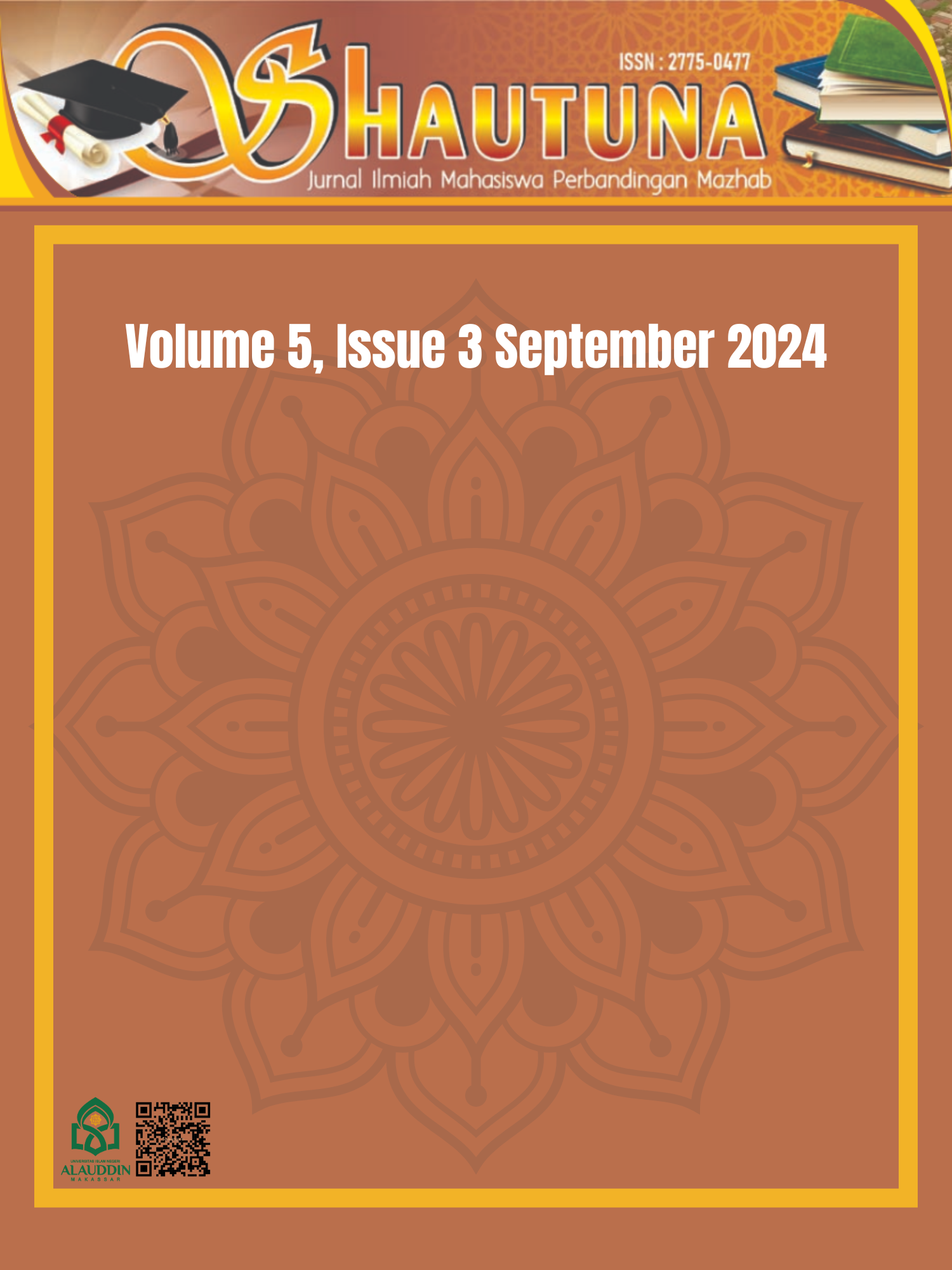Evidence and Qualification of Criminal Elements for Synthetic Tobacco Narcotics Crimes in Indonesia
DOI:
https://doi.org/10.24252/shautuna.v5i3.51940Keywords:
Criminal Evidence and Qualification, Criminal Elements, Narcotic, Synthetic TobaccoAbstract
This study aims to analyze the process of evidence against the crime of narcotics synthetic Tobacco species regulated in Article 114 and Article 112 of law no. 35 Of 2009 On Narcotics. The research method used is normative legal research, which examines and interprets relevant legal regulations, legal documents, and legal doctrines in the context of evidence against synthetic tobacco narcotics crimes. This research is the latest research because there is no scientific work such as dissertation, thesis, thesis, national or International Journal that specifically discusses the evidence against synthetic Tobacco narcotics crimes under Article 114 and Article 112 of law no. 35 Of 2009 On Narcotics. The results showed that the legal qualification against synthetic Tobacco narcotics offense, as stipulated in Article 112 paragraph (2) and Article 114 paragraph (2) of law no. 35 of 2009 on narcotics, found a legal vacuum because synthetic tobacco is not clearly included in the classification of Narcotics Group I both derived from plants and non-plants, due to differences in sources, manufacturing processes, chemical composition, and effects on users. Regulations such as Kepmenkes No. 246 / Menkes/SK / 2017 on narcotics, ago guidelines No. 18 of 2021, and Perkap No. 6 of 2019 concerning the investigation of criminal offenses does not provide clarity regarding the classification of synthetic tobacco as Class I narcotics. In the aspect of criminal evidence against synthetic Tobacco narcotics, the evidence is carried out in a similar way to natural marijuana, which is a narcotic plant type i, where the entirety of synthetic tobacco is weighed, causing ambiguity in law enforcement.
References
Alice G. Walton, PhD. “Why Synthetic Marijuana Is More Toxic To The Brain Than Pot.” www.forbes.com, 2022.
Chumbhadrika, Chitto, dan Heykal Pradhana. “Urgensi Pengelompokkan Ganja Sintetis Ke Dalam Golongan I UU No. 35 Tahun 2009 Tentang Narkotika.” Iblam Law Review 4, no. 2 (2024): 143–57. https://doi.org/10.52249/ilr.v4i2.478.
Dewi, Wijayanti Puspita. “Penjatuhan Pidana Penjara Atas Tindak Pidana Narkotika Oleh Hakim Di Bawah Ketentuan Minimum Ditinjau Dari Undang-Undang Nomor 35 Tahun 2009 Tentang Narkotika.” Jurnal Hukum Magnum Opus 2, no. 1 (2019): 55–73. https://core.ac.uk/download/pdf/229337812.pdf.
Fatahilla, Krisfian, Sufirman Rahman, dan Baharuddin Badaru. “Efektifitas Pemidanaan dalam Proses Penegakan Hukum Tindak Pidana Penyalahgunaan Narkotika.” Journal of Lex Generalis (JLG) 3, no. 4 (2022): 743–57. http://www.pasca-umi.ac.id/index.php/jlg/article/view/832.
Ingegneri, Mariarosaria, Erika Smeriglio, Younes Zebbiche, Laura Cornara, Letterio Visalli, Antonella Smeriglio, dan Domenico Trombetta. “The Dark Side of ‘Smart Drugs’: Cognitive Enhancement vs. Clinical Concerns.” Toxics 13, no. 4 (2025): 247. https://doi.org/10.3390/toxics13040247.
Investigative, Houston, An Initiative, dan Houston Hidta August. “Assessment on Synthetic,” 2015.
Kementerian Kesehatan. “Peraturan Menteri Kesehatan Republik Indonesia Nomor 36 Tahun 2022 Tentang Perubahan Penggolongan Narkotika Golongan dan Jenis Narkotika.” JDHI Database Peraturan, no. 1200 (2022): 1–18. www.peraturan.go.id.
Marzuki, Peter Mahmud. Penelitian Hukum. Jakarta: Kencana Prenada Media Group, 2010.
Muharam, Husaini Satria, dan Amrizal Siagian. “Tindak Kejahatan Penyalahgunaan dan Pengedaran Narkotika Tembakau Sintetis di Wilayah Kebayoran Lama Ditinjau dari Rational Choice Theory.” UNES Law Review 6, no. 4 (2024): 10795–806. https://doi.org/10.31933/unesrev.v6i4.1954.
Piyan, Priatama. “Peran Badan Narkotika Nasional dalam Menanggulangi Penyalahgunaan Narkotika Jenis New Psychoactive Substances (Studi Kasus di Badan Narkotika Nasional Kota Tangerang),” 2024.
Seely, Kathryn A, Jeff Lapoint, Jeffery H Moran, dan Liana Fattore. “Spice Drugs Are More Than Harmless Herbal Blends: A Review of The Pharmacology and Toxicology of Synthetic Cannabinoids.” Progress in Neuro-psychopharmacology and biological psychiatry 39, no. 2 (2012): 234–43. https://doi.org/10.1016/j.pnpbp.2012.04.017.
Sidabalok, DANIEL. “Analisis Yuridis Terhadap Narkotika Jenis Baru yang Belum di Atur dalam Undang-Undang No. 35 Tahun 2009 Tentang Narkotika (Studi Terhadap Tembakau Gorila).” Universitas Islam Riau, 2019. https://repository.uir.ac.id/7965/1/141010261.pdf.
Sulastiana, Kombes Pol Dr, dan S H SIP. Mengungkap Ekologi Kejahatan Narkotika. PT. Rayyana Komunikasindo, 2021.
Tatumpe, Asrid. “Penegakan Hukum Terhadap Pelaku Tindak Pidana Narkotika di Sulawesi Utara.” Journal Scientia De Lex 6, no. 1 (2018): 1–16. http://ejournal.unpi.ac.id/index.php/scientia/article/view/32.
Yaya Satyanagara, S H, Novy Khusnul Khotimah MH, dan Kom SI. Implementasi Pencegahan dan Pemberantasan Penyalahgunaan & Peredaran Gelap Narkotika. CV Jejak (Jejak Publisher), 2024.
Downloads
Published
How to Cite
Issue
Section
License
Copyright (c) 2024 Andika Prawira Buana, Muhammad Fauzi Ramadhan, Andi Amalia Suhra, Kaisar Kaisar

This work is licensed under a Creative Commons Attribution 4.0 International License.









